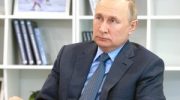If weapons have to be sent to Ukraine to counter Moscow's bloody ambitions, the battle with Beijing continues almost imperceptibly, but it may affect the future even more than the outcome of the Russian-Ukrainian war.

If you suddenly did not notice, let me warn you about a fresh turn of events: the USA is now in conflict with Russia and China at the same time. Henry Kissinger always warned against it.
But, unfortunately, the national interest has good reasons to oppose them both today. But, without a doubt, the US has entered uncharted waters. One can only hope that this is not a new “eternal war”, – writes the American journalist and three-time Pulitzer Prize winner Thomas Friedman in an article for the New York Times.
The struggle with Russia is indirect, but obvious, it is cruel and is intensifying. The US is arming the Ukrainian army with high-precision missiles and intelligence data to force the Russians to leave Ukraine.
“Without belittling the bravery of the Ukrainians, it is worth saying that the support of the US and NATO played a huge role in the Ukrainian success on the battlefield. Ask the Russians. But how will this war end? No one can say,” the author writes.
However, he suggests paying attention to the struggle that the United States is waging against China. It is less obvious and takes place without shots. Because it is conducted mostly by transistors that switch between values 1 and 0. But this battle will have as much, if not more, impact on the global balance of power than the war between Russia and Ukraine. And Taiwan has nothing here at all.
This is a battle for semiconductors, the basis of technology in the information age. The alliance, which will design and manufacture the smartest chips in the world, will have the world's most accurate weapons, the world's most efficient factories, and the smartest quantum computing tools capable of breaking any encryption. Today, the United States and its partners are ahead. But China is resolutely trying to catch up with them. And now the West is no less determined to prevent this. The game has begun.
Read also: Politico: Russia is looking for chips to replenish the stockpile of weapons spent in Ukraine, it became known what details the Kremlin needs
Last week, the Joe Biden administration released a new package of export restrictions that effectively said to China: “We think you are three technological generations behind us in the development of logic chips, memory chips and hardware. And we're going to make sure you never catch up to us.” The US president's national security adviser, Jake Sullivan, put it more diplomatically: “Given the foundational nature of certain technologies, such as advanced logic chips and memory chips, we must maintain as much advantage as possible.”
“The U.S. has effectively declared war on China's ability to develop high-performance computing applications in the economy and security,” said Paul Triolo, a China and technology expert at the consulting firm Albright Stonebridge.
Or, as the Chinese embassy in Washington called it, The US seeks “high-tech hegemony”. But when will this war end? No one can say.
“I don't want to be torn apart by China, which is increasingly using technology for total control at home and creeping projection of power abroad. But if we are now stuck on the path of depriving China of advanced technology forever, destroying any hope of mutually beneficial cooperation with Beijing on climate and cybercrime, as we face common threats that only two states can solve, what kind of world will we build? China should also ask these questions,” Friedman writes.
On Friday, the U.S. Commerce Department released rulings that build a powerful barrier that will block China's ability to buy the best semiconductors in the West or the equipment to make them at home. The new orders also prohibit any American engineer or scientist from helping China develop chips without special permission. Even if an American works on equipment in China that is not subject to export restrictions. All of this screw-up is necessary to prevent US-developed chips sold to civilian companies in China from falling into the hands of the Chinese military.
Also read: Nvidia, AMD banned from selling top AI chips to China in US – Reuters
And perhaps most controversially, Biden's team added a “foreign product rule” that it says The Financial Times, “was first used by the Donald Trump administration against Chinese technology group Huawei” and “essentially prohibits any US or non-US company from supplying targeted Chinese entities with hardware or software whose supply chain includes US technology”.
And this last rule is very serious. Because most advanced semiconductors were developed by a “complex coalition” of companies from America, Europe and Asia. You can think of it this way: AMD, Qualcomm, Intel, Apple, and Nvidia are making breakthroughs in the design of chips that contain billions of transistors packed together extremely densely to provide the necessary computing power. Synopsys and Cadence create sophisticated automated design tools and software that enable chip manufacturers to actually design their newest ideas. Applied Materials creates and modifies materials to make billions of transistors and interconnects on a chip. Netherlands-based ASML provides the lithography tools in partnership with, among others, Zeiss SMT, a German optical lens company that stencils these designs on silicon wafers using both deep and extreme ultraviolet light—light with a very short wavelength that can print tiny patterns on a microchip. Intel, Lam Research, KLA and companies from Korea to Japan and Taiwan also play key roles in this coalition.
Here's the thing: the more we push the boundaries of physics and materials science to cram more transistors onto a chip and get more computing power to continue to advance artificial intelligence, the less likely it is that any one company or country will be able to achieve absolute success at all stages of design. and production process. This requires the entire coalition. The reason Taiwan Semiconductor Manufacturing Company, known as TSMC, is considered the world's leading chipmaker is that each member of this coalition trusts TSMC with their most secret trade secrets, which it then pools and uses for the benefit of all.
But the coalition partners do not trust China, fearing that it will steal their intellectual property. Therefore, Beijing can only try to copy what the world's technological stars have developed with the help of its outdated technologies. Actually, he managed to steal certain technologies, in particular TSMC's 28-nanometer technology in 2017. Until recently, China's top chipmaker Semiconductor Manufacturing International Company was thought to be stuck at this level, although it says it has been able to build chips at 14-nanometer and even 7-nanometer scales using ASML's older-generation deep-UV lithography. American experts say that even so, China cannot launch mass production of such chips without the precision of the latest ASML technology. And it is now prohibited to export it to China.
Related video
The Chinese state publication Global Times wrote in an editorial that the ban will only “strengthen China's will and ability to rely on its own science and technology.” Bloomberg quoted an unnamed Chinese analyst as saying there was “no room for reconciliation.” Well, welcome to the future!




